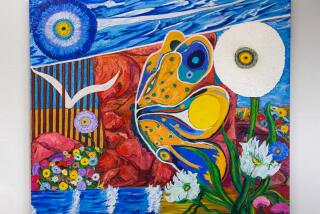GARDENING : Attracting Butterflies: Idea Takes Wing in Book
Most gardeners find butterflies enchanting. But some see them only as the parents of nasty caterpillars that devour prized vegetation.
Jerry Sedenko definitely falls in the first group, and his new book, “The Butterfly Garden,” details how to attract them with flowers and plants no matter where you live or what your gardening skills.
“Perhaps you’re a bit concerned that all your efforts at plant nurturing will be laid to waste by armies of munching caterpillars,” Sedenko says. “Not to worry. The larvae of many butterfly prefer to feed on ‘undesirables,’ if not downright weeds.
“The risk of losing a plant to their attentions is very small. If you find that your favorite plant is also a favorite with your butterflies, grow more of it so that there will be enough for everybody!”
In recent years there has been a dramatic decline in many butterfly populations as a result of urban expansion. The butterfly gardening concept is designed to conserve their environment and attract more of them to populated areas.
Sedenko, a zoology graduate from the University of California at Davis who now lives in Seattle, profiles 25 favorite butterfly species and includes their favorite foods in both the larval and adult stage. Since all butterflies have a life cycle that includes a leaf-eating caterpillar and a free-flying adult butterfly, there must be food nearby for both stages to have butterflies.
Sedenko’s list of recommended plants is extensive and includes common names, botanical names, pictures, cultural and propagation tips, the type of butterflies likely to be attracted to each and the seasons they appear.
“Caterpillars of the Gulf Fritillary call (the passionflower) vine home,” Sedenko adds, quite honestly, in what a lot of growers of passionflower fruit will consider a gross understatement.
But more gardeners, of course, will want information on how to attract adult butterflies than how to discourage caterpillars, and here Sedenko shines.
“Fortunately, there are many plants that are highly ornamental, appropriate to traditional garden styles and that just happen to attract butterflies,” he says.
As an example, lantana is described as one of the best attractants, “blooming spring through fall, and year-round in frost-free areas” and “especially attractive to Gulf Fritillary, Monarch, Spicebush Swallowtail and Cabbage White.”
Common heliotrope ( Heliotropium arborescens ), which blooms summer through fall, “is a most enticing flower for the butterflies in your garden.”
Ageratum, cosmos, candytuft, marigold, tithonia, nasturtium, sweet alyssum, zinnia, pinks, mignonette, phlox, forget-me-not, viola, lupine, mallow, pincushions, sunflower, sweet williams and verbena are listed as “other good butterfly annuals.”
Before plunging ahead, however, consider also that “butterflies need sun” and their “wings are delicate things, prone to tearing in strong or gusty winds.”
So a sheltered garden site is important and “a heavily shaded garden, or one on the north side of a house, will not prove very inviting.” Since butterflies cannot drink from open water, a birdbath-type facility won’t work.
“What is needed is a sunny, damp spot, be it sandy or muddy. A small plastic basin, buried in the soil and filled with sand or earth, will furnish just the right amount of moisture. If you put the basin near a hose bibb, it will be easier for you to keep it filled.”
“The Butterfly Garden” ($25 in hardcover) has 144 pages and 100 color pages. It is published by Villard Books, a division of Random House.
And if you’ve ever wondered: Sedenko says the origin of the word “butterfly” is uncertain “but was probably first used to refer to the butter-colored species.”






